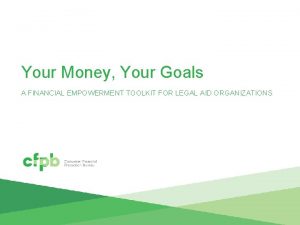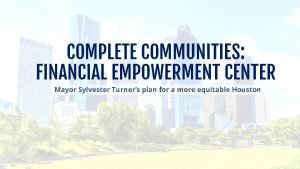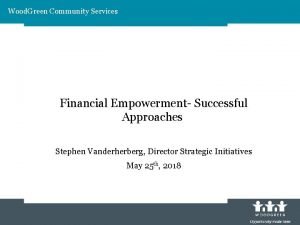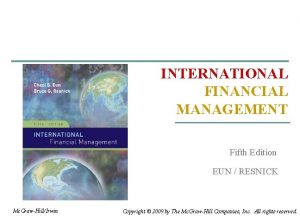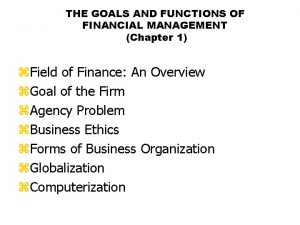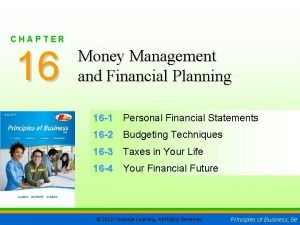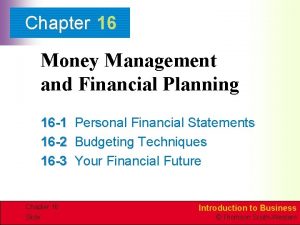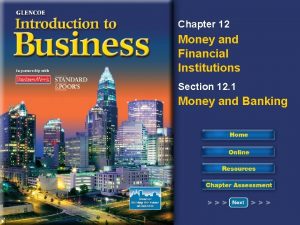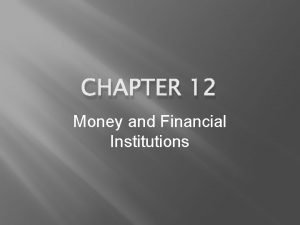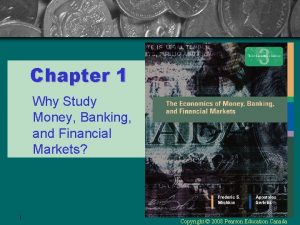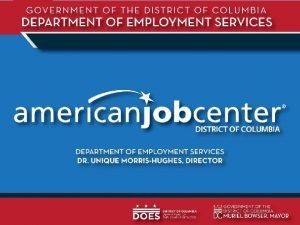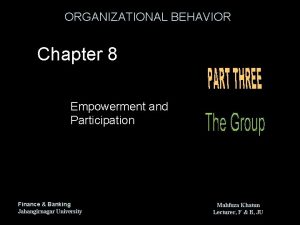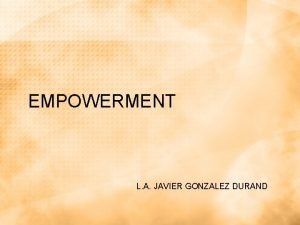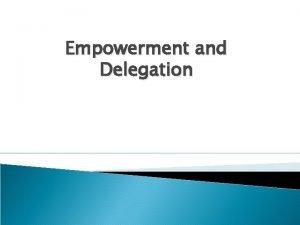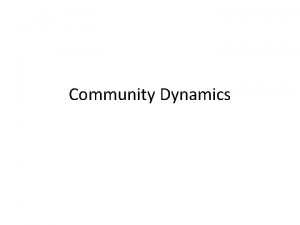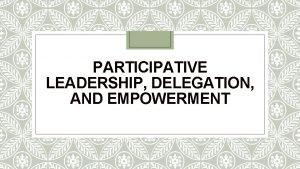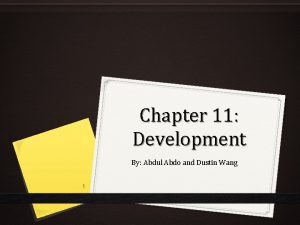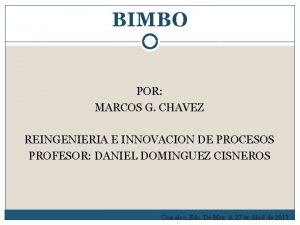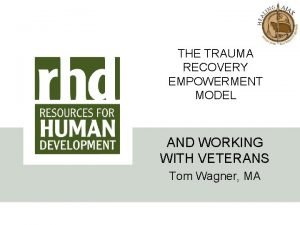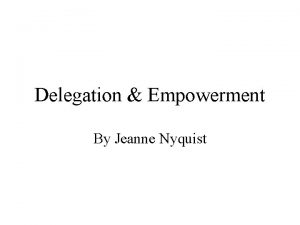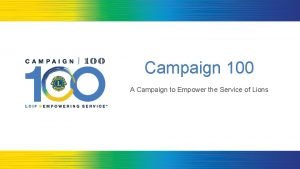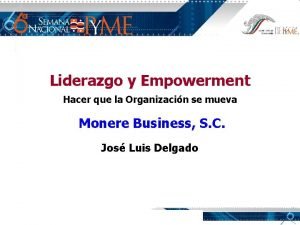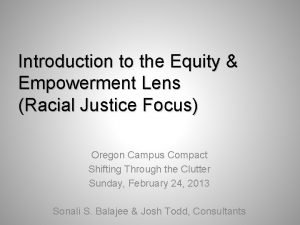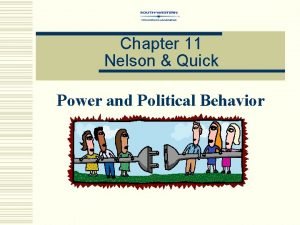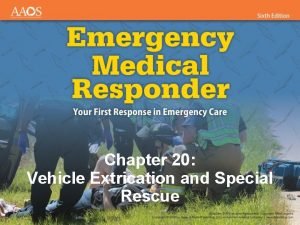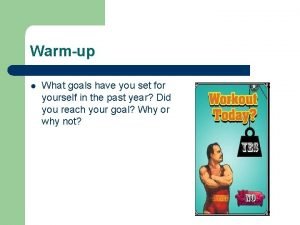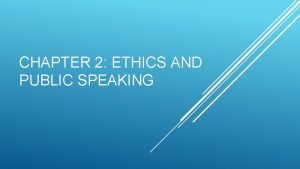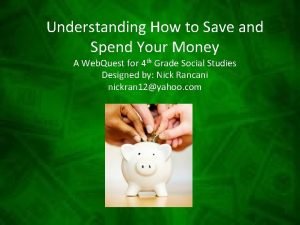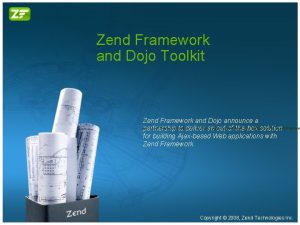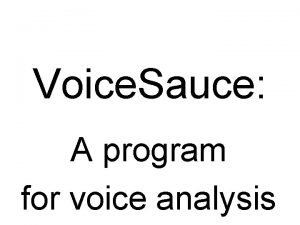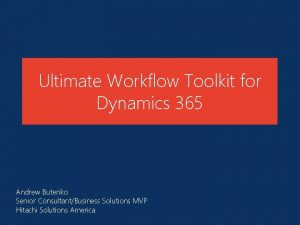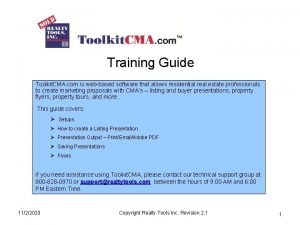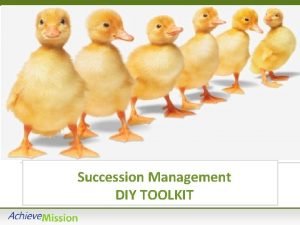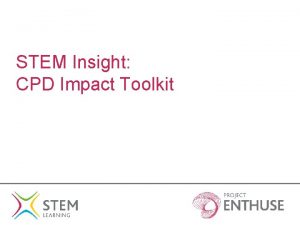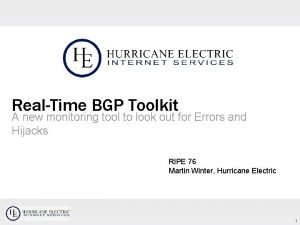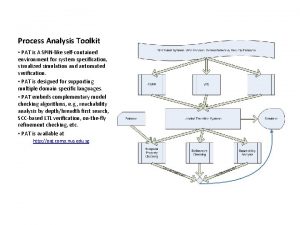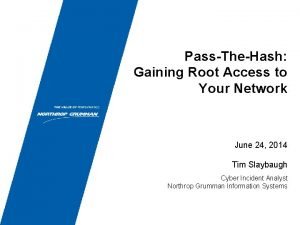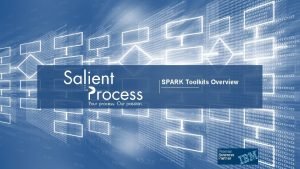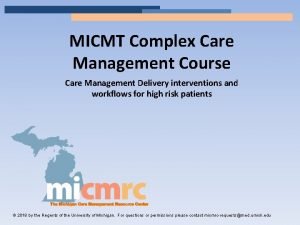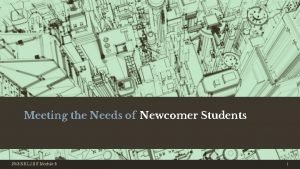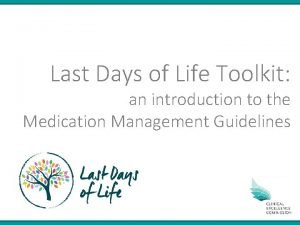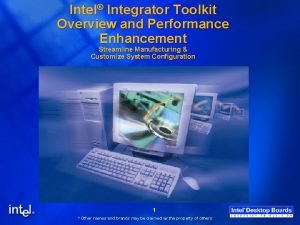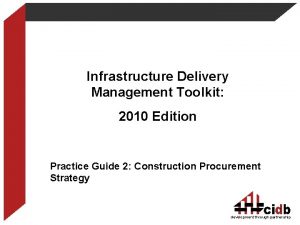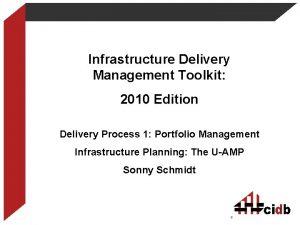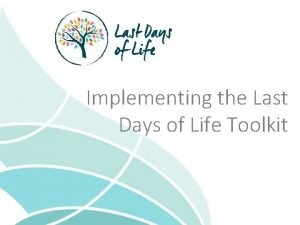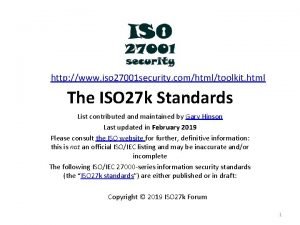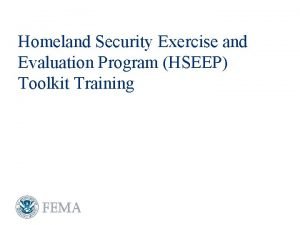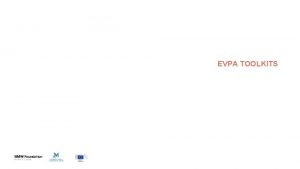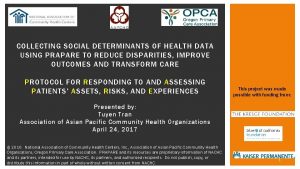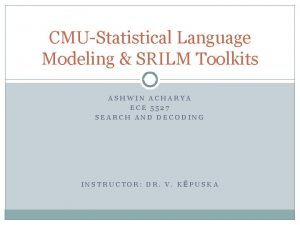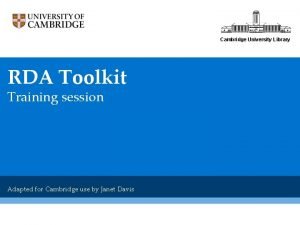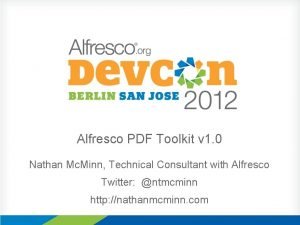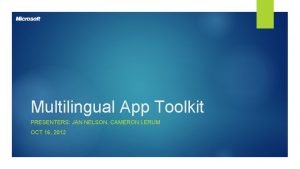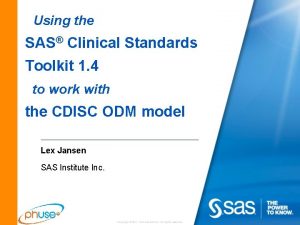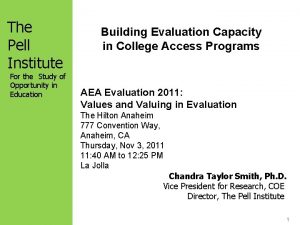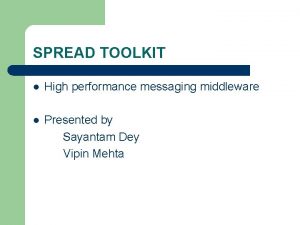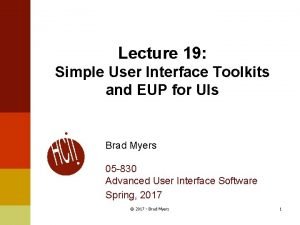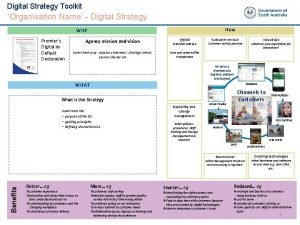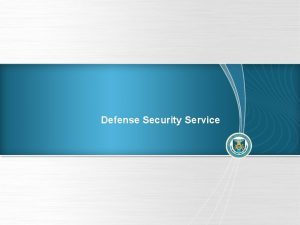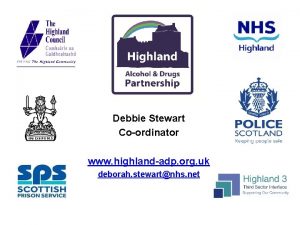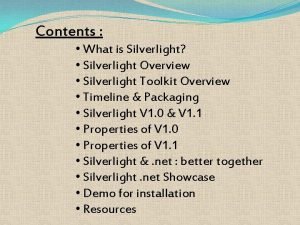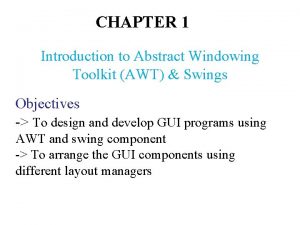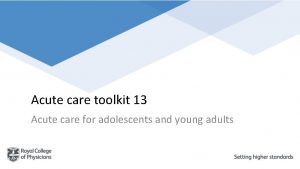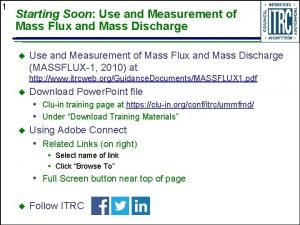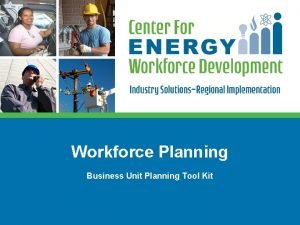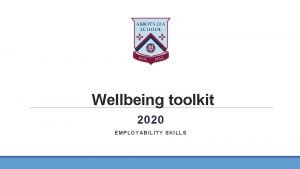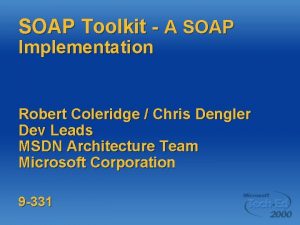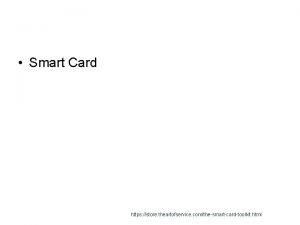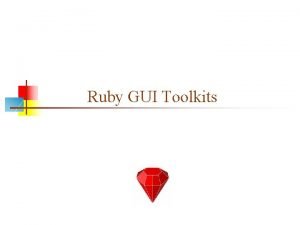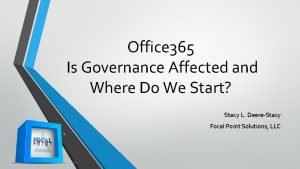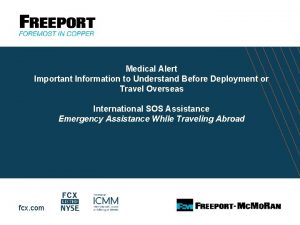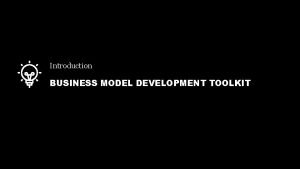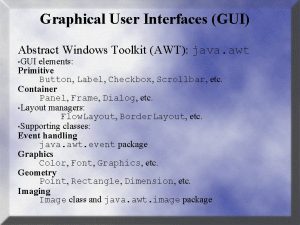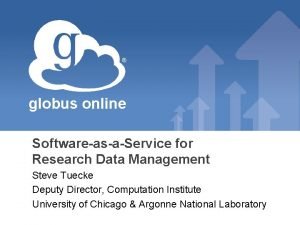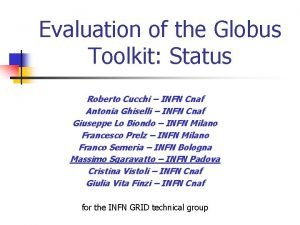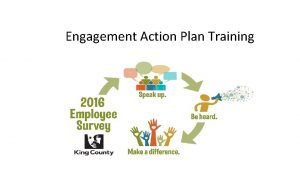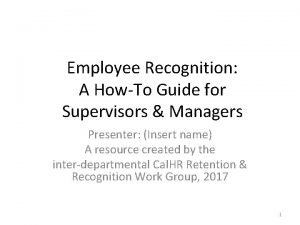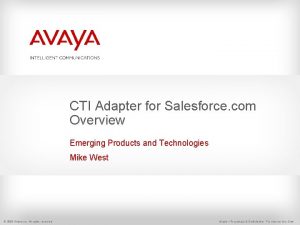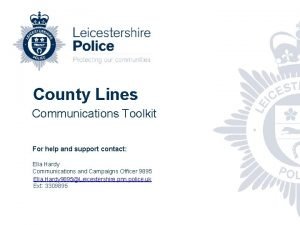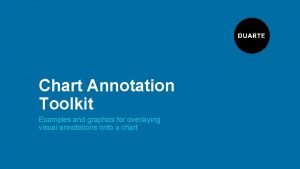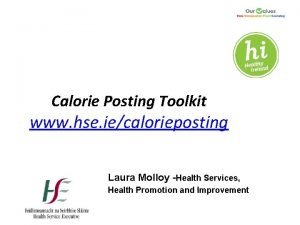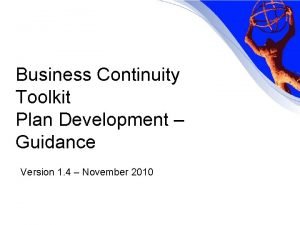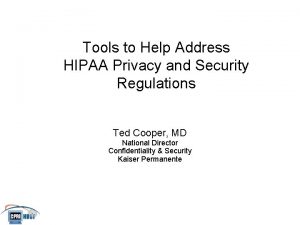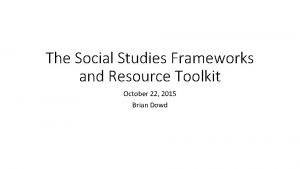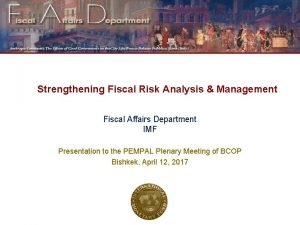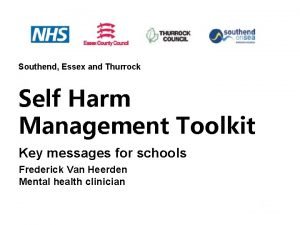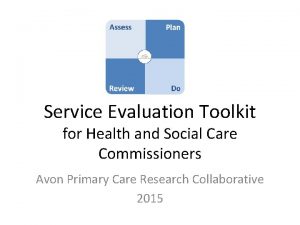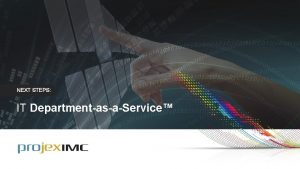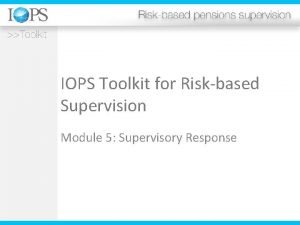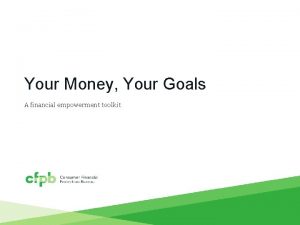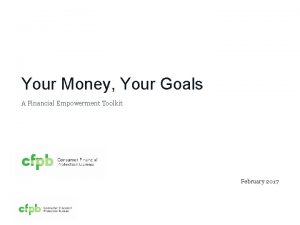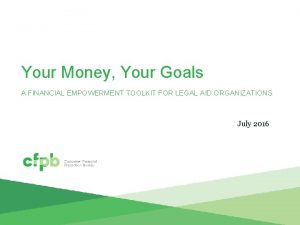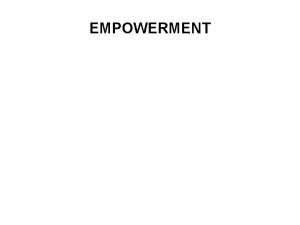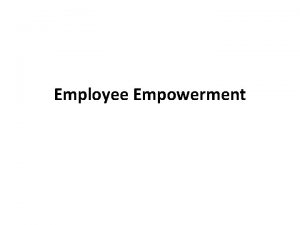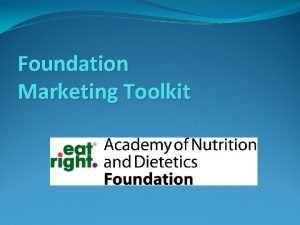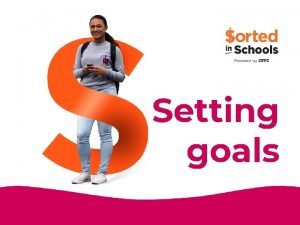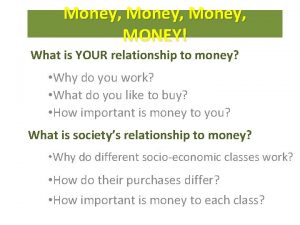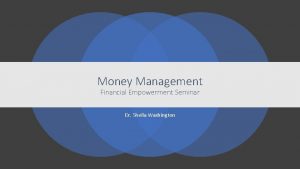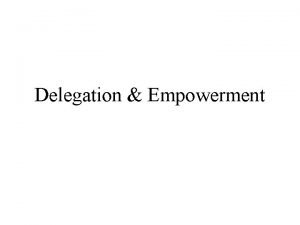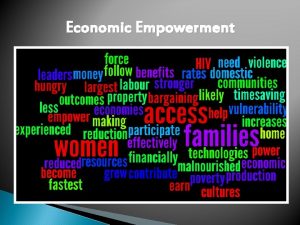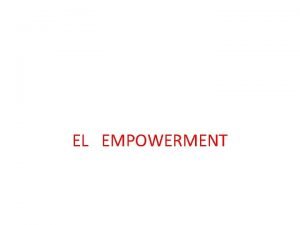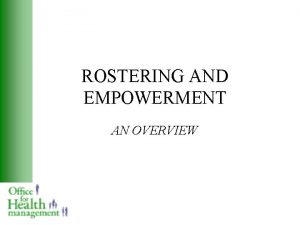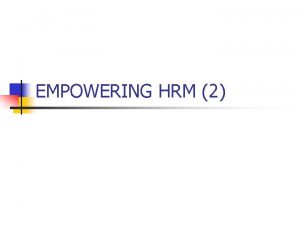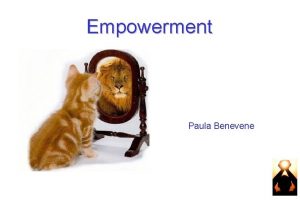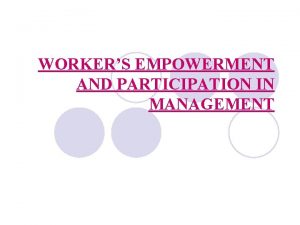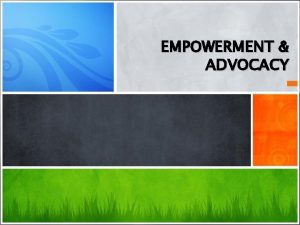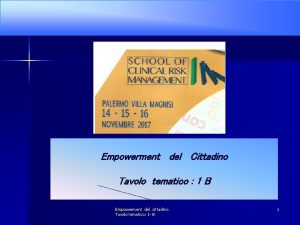Your Money Your Goals A FINANCIAL EMPOWERMENT TOOLKIT


















































































































































































- Slides: 178

Your Money, Your Goals A FINANCIAL EMPOWERMENT TOOLKIT FOR LEGAL AID ORGANIZATIONS

Your Money, Your Goals Opening Activity 2

Money and me: Opening activity List all of the words, phrases, sayings, songs, or other associations you have with the word money. 3

Money and me: Opening activity money any generally accepted medium of exchange 4

Money: What does it mean? § Where do our associations about money come from? § How do these associations reflect our attitudes and feelings about money? § How are our attitudes and feelings related to our behaviors and actions? § So what does this mean when we are working with individuals on financial empowerment? 5

Your Money, Your Goals Overview of the training and introductions 6

Training purpose § To provide you with: An orientation to Your Money, Your Goals—the CFPB’s financial empowerment tools Strategies for using the toolkit The tools, knowledge, and confidence to provide financial empowerment services to clients of legal aid organizations 7

Training objectives By the end of the training, you will be able to: § Explain the ways outcomes of financial empowerment training align with your program outcomes as well as the outcomes of the individuals you serve. § Demonstrate increased confidence in your own knowledge about core financial management topics. § Assess clients of legal aid organizations’ financial conditions or situations. § Provide the right financial content at the right time in the context of your service provision to clients based on conversations, the legal issues being addressed by your legal aid organization, or assessment. 8

Training objectives By the end of the training, you will be able to: § Use specific tools to help clients of legal aid organizations reach their own goals in different workplace, cultural, and situational contexts. § Access and use tools and materials, including how to submit a complaint, available at www. consumerfinance. gov. § Make appropriate and specific referrals to help legal aid clients manage their financial challenges. § Know where to go for unbiased information or help in providing financial empowerment services. 9

Training presenter § The Consumer Financial Protection Bureau created the Your Money, Your Goals toolkit for consumers, as well as the training materials presented today. These materials are being presented to you by a local organization. The organizations or individuals presenting these materials are not agents or employees of the CFPB, and their views do not represent the views of the Bureau. The CFPB is not responsible for the advice or actions of these individuals or entities. The Bureau appreciates the opportunity to work with the organizations that are presenting these materials. 10

Introduction activity § Share name § Organization § Role within the organization § “What do you expect or hope to get from this training? ” 11

Training agenda § Money and me: opening activity § § Overview of the training and introductions Tracking and managing income and benefits § Paying bills and other expenses § Getting through the month § Dealing with debt § Understanding credit reports and scores § Saving for emergencies, goals, and bills § Introduction to the CFPB and resources for legal aid organizations § Submitting a complaint to the CFPB § Your Money, Your Goals: How to use the toolkit § The role of referral § Assessing the situation § Shopping for Financial services § Setting goals and planning for purchases § Closing 12

Your Money, Your Goals Introduction to the CFPB and resources for legal aid organizations 13

Introduction to the CFPB § Consumer Financial Protection Bureau § The CFPB’s mission is to make markets for consumer financial products and services work for consumers. 14

Introduction to the CFPB § Education § Oversight § Regulations § Study 15

CFPB resources for legal aid organizations § Regulatory information § Ask CFPB § Get Assistance materials § Submit a complaint § Resources for service members, students, and older Americans 16

Protecting consumer rights—CFPB and key consumer finance laws § Equal Credit Opportunity Act and Regulation B § Home Mortgage Disclosure Act (HMDA) and Regulation C § Electronic Fund Transfer Act (EFTA) and Regulation E § Fair Debt Collection Practices Act and Regulation F 17

Protecting consumer rights—CFPB and consumer finance laws § Consumer Leasing Act and Regulation M § Privacy of Consumer Financial Information – Gramm-Leach-Bliley Act and Regulation P § Fair Credit Reporting Act and Regulation V § Real Estate Settlements Procedures Act and Regulation X 18

Tool 1: Submitting a complaint to the CFPB § Describe what happened, in as much detail as possible § Describe what you think a fair resolution to the issue would be § Provide your information (name/address/email) § Provide detailed information about the product and company you are complaining about. Please scan and upload any documentation that you have here (account agreements, monthly statements, proof of payment, etc. ). § Ability to file on behalf of oneself or other, e. g. , client 19

Tool 1: Submitting a complaint to the CFPB § Complaint submitted § Complaint reviewed and routed § Company response 20

Tool 1: Complaint process § Consumer review § CFPB review and investigation § Analysis and report 21

Your Money, Your Goals Financial empowerment and an orientation to the toolkit 22

CFPB, financial empowerment, and legal aid staff Access Trust Opportunities for providing financial empowerment 23

Financial empowerment What is financial empowerment? How is it different from financial education, financial literacy, financial capacity, or other commonly used terms? Financial literacy Skills and Access Financial empowerment 24

Benefit / cost of providing financial empowerment What are the benefits of financial empowerment What are the costs of financial empowerment § For you? § For your clients? § For your organization? 25

Organization of Your Money, Your Goals Overview Module 1: Assessing the situation Module 2: Setting goals and planning for purchases Module 3: Tracking and managing income and benefits Module 4: Paying bills and other expenses Module 5: Getting through the month Module 6: Dealing with debt Module 7: Understanding credit reports and scores Module 8: Saving for emergencies, goals, and bills Module 9: Money services, cards, accounts, and loans: Finding what works for you

Organization of Your Money, Your Goals § Do not treat like a curriculum. § Provide the right content and tools at the right time. § Use in discussions with clients of legal aid organizations or assessments to figure out where to start. § Use in discussions with client when there is overlap between legal issue and financial issue, e. g, debt collection 27

Where would you start if a client… 1. Felt overwhelmed by debt? 2. Felt like she couldn’t make ends meet? 3. Wants to buy a car and get the best rate she can for the money she must borrow? 4. Wants to understand direct deposit and payroll cards? 5. May qualify for EITC? 28

Where would you start if a client… (continued) 6. Has used high-cost credit products in the past and wants to avoid these in the future? 7. Wants to make changes but does not have clear goals? 8. Has many financial issues, and you don’t know where to start? 9. Has no savings but wants to start? 10. Wants to open an account but doesn’t know what kind of account or where? 29

Integration: Using the toolkit with clients of legal aid organizations Learn toolkit content Increase comfort with tools Introduce FE service provision Capture outputs and outcomes If you want to test your knowledge on consumer finance issues, take the Knowledge assessment quiz – available at the YMYG webpage 30

Financial empowerment quiz for legal aid staff Complete the financial empowerment quiz for legal aid staff. Reflection Questions § Were there answers that surprised you? If yes, which ones? § Were there topics you knew more about than you thought you would? § Of the topics covered by the quiz, which would be most useful to your clients? § What topics would you like to learn more about? § How can you learn more about them? 31

Making the most of your time with clients

Putting the toolkit into action Intake staff Paralegal or staff attorney § Incorporate questions into routine intake process § Use assessment information gathered by intake staff and knowledge of client, identify specific modules and tools § Use their organizations’ case management systems to flag clients that are candidates for financial empowerment information § Distribute tools and information based on the intake § Integrate conversations about finances into meeting(s) § Follow up on information and tools covered in previous meetings 33

Your Money, Your Goals The role of referral 34

The role of referral § Financial empowerment = VERY BIG TOPIC § No one person knows everything § Your time is limited with clients § Know your limits of knowledge and time, know your partners, and refer! 35

The right referral partner § High quality = factual, accurate, and current § Unbiased = not influenced by factors that benefit the information provider 36

Identifying resource and referral partners Area of Assistance Possible Referral Partner Cash Flow Budgeting Benefits Screening Income Tax Preparation and Filing Managing Debt Dealing with Debt Collectors Understanding Credit Reports and Scores Fixing Errors on Credit Reports and Scores Using Financial Services Protecting Consumer Rights Asset Building Other 37

Your Money, Your Goals Module 1: Assessing the situation 38

Situation assessment A picture of conditions today used to inform and plan for actions to change conditions in the future 39

Client situation assessment role play § Role 1 = Client Role play client and complete assessment as instructed by the service provider once you “feel comfortable” during the meeting. § Role 2 = Staff or others delivering financial empowerment Start discussion, introduce assessment when appropriate, analyze assessment (if time allows), make a plan for financial empowerment work. § Role 3 = Observer Watch discussion, take notes using form, provide feedback. 40

Client situation assessment role play Client § How did it feel taking the assessment? § What did the service provider do to make you feel more comfortable answering these questions? § Was there anything that could have made the situation less stressful or threatening? § Did you feel the steps outlined following the assessment made sense for you (if there was time during the role play)? 41

Client situation assessment role play Service provider § How did it feel introducing the assessment? § How comfortable was it “analyzing it” on the spot? Why is relatively quick analysis important? § What do you think you did to make the situation comfortable for your client? § How useful do you think this tool will be in the work you do with clients of legal aid organizations? 42

Client situation assessment role play Observer § What were the most effective techniques used in listening to and talking with the clients of legal aid organizations? § What could have made the situation even better for the client? § How well did the assessment work in the context of a “meeting? ” § How useful do you think this tool will be in the work you do with clients of legal aid organizations? 43

Other strategies for starting the conversation Brainstorm specific opportunities for beginning the financial empowerment conversation with clients of legal aid organizations. 44

Your Money, Your Goals Module 2: Setting goals and planning for purchases 45

Module 2: Setting goals and planning for purchases § Work toward making your future better. § Prioritize how you spend your money so that it goes toward things that really matter to you. § Measure and track your progress toward getting the things you want out of life. § Take pride in bettering your life and the lives of your children. 46

SMART goals § Specific § Measurable § Able to be reached § Relevant § Time-framed 47

Hopes, wants, and dreams vs. strong goal Hopes, wants, and dreams Strong goal I’d like to buy a new television. I will save $400 and purchase a new television in six months. I want to get out of credit card debt. I will pay down $1, 000 of my debt in the next year. 48

Tool 1: Goal Setting Tool § Brainstorm list of hopes, wants and dreams § SMART goals § Action plan § Figure out weekly savings target 49

Tool 1: Action plan Goal: ________________ 50

Calculating amount to set aside each week Total amount needed Number of weeks to reach goal Amount to set aside each week 51

Life cycle events and large purchases What is a life cycle event likely to cost? Everyone is different, but here are some estimates we have seen: § Out of pocket childbirth expenses for women with insurance coverage—$3, 400 § Out of pocket expenses associated with breast cancer—$712/month § Quinceañera—coming of age celebration for 15 -year old girls in Latino families--$15, 000 to $20, 000 § Typical cost for final expenses—$10, 000

Planning for life events and large purchases § Group 1: 18 -year old graduating from high school. Plans to attend trade school to become a skilled welder. § Group 2: 28 -year old food services manager at a state university diagnosed with cancer. He is part of the union. He is married and has an infant. § Group 3: 36 -year old mother divorcing her husband with 2 children ages 4 and 8. Must reenter the workforce; before children she was a math teacher in the public school system. § Group 4: 45 -year old man being downsized out of manufacturing job. Married with one child who is 15 years old. The child has plans to go to college out of state. § Group 5: 56 -year old carpenter hoping to retire in 6 years. Has saved minimally for retirement. Children are grown and out of the house; however, one has plans to return home after losing job with his two children under age 5. 53

Planning for life events and large purchases § What are the reasons for thinking about and anticipating life events and large purchases? § Do most people do this? Why or why not? § How does an exercise like this empower clients of legal aid organizations? § How can an exercise like this backfire? § What did you learn from this exercise? 54

Tool 2: Planning for life events and large purchases Large purchase or life event Cost of large purchase or life event Within 1 year Between 1 and 2 years from now Between 2 and 5 years from now Between 5 and 10 years from now Between 10 and 15 years from now Ways to pay Ways to cut expenses/ reduce the overall cost Between 15 and 20 years from now Over 20 years from now 55

Tool 3: Buying a car § When you buy a car, you can: Pay for it in cash Borrow money to pay for it and pay it back over time § Auto loans are available from: Credit unions Banks Finance companies Car dealers 56

Tool 3: Buying a car § The amount of interest and fees (the Annual Percentage Rate or APR) you pay on a loan may depend on: Your credit history and score The term of the loan The price of the car you are buying § APRs are lower for people with positive credit histories and high credit scores. § The APR is also generally lower when you buy a new car.

Module 2: Wrap up § SMART goals can provide direction to financial plans. § SMART goals can help you plan for the money you need to reach your goals. § Action plans can help you ensure you have the information and resources you need to reach your goals. § Anticipating life events and large purchases including cars can empower you to plan and save for them. § Use Tool 1: Goal setting tool to set SMART goals, make plans, and figure out weekly savings target. § Use Tool 2: Planning for life events and large purchases to anticipate and plan for the expenses associated with these. § Use Tool 3: Buying a car to discuss key considerations before buying a car. 58

Your Money, Your Goals Module 3: Tracking and managing income and benefits 59

Income, benefits and wage garnishments Income § Regular income § Irregular income § Seasonal § One-time occurrence Benefits Wage garnishments 60

One-time Seasonal Irregular Regular Total Week 4 Week 3 Week 2 Week 1 Tool 1: Income and resource tracker Job Second job Self- employment income SNAP TANF SSI Child support Gift Tax refund Weekly total 61

Tool 2: Ways to increase income and resources § Review this tool. § Think about clients of legal aid organizations. § Which strategies listed do you think are potentially feasible? Circle these. § What strategies are missing? Add these. § Understand sensitivities and that options are very limited for clients. 62

Tool 2: Ways to increase income and resources 63

Tool 3: Choosing how to receive income and benefits § Cash § Paychecks § Direct deposit § Payroll cards § EBT 64

Tool 3: Choosing how to receive income and benefits 65

Tool 4: Increasing your income through tax credits § For the 2014 tax year the following income limits and maximum Earned Income Tax Credits apply: § Also, investment income must be $3, 350 or less for the year. § All information regarding tax credits from the Internal Revenue Service at www. irs. gov. 66

Tool 5: Understanding garnishment § Garnishment of wages § Garnishment from a bank or credit union account § Money owed to the bank or credit union where an individual has an account 67

Module 3: Wrap up § Income is all of the money or financial resources that come into your household. § Managing irregular or seasonal income is challenging and hard to plan with. § Wage garnishments for debts or other unpaid obligations will reduce your take home income. 68

Module 3: Wrap up § Use Tool 1: Income and resource tracker to understand when and how much income and benefits you receive. § Use Tool 2: Ways to increase income and resources to identify ways to possibly increase your income or financial resources. § Use Tool 3: Choosing how to receive income and benefits to better understand the benefits and risks of different ways of receiving income and benefits. § Use Tool 4: Increasing your income through tax credits to learn more about tax credits that may increase your income. § Use Tool 5: Understanding garnishment when it applies. 69

Your Money, Your Goals Module 4: Paying bills and other expenses 70

Module 4: Paying bills and other expenses Spending § Money you use to pay for a wide range of basic needs, your financial obligations, and other things you may want. Needs, wants, and obligations § Needs are things you must have to live. § Wants are things you can survive without. § Obligations are things you must pay because you owe someone money (a car loan) or have been ordered to pay someone (child support). 71

Tool 1: Spending tracker Savings Saving for goals, saving for emergencies, saving for children’s education, saving for retirement, saving for holiday purchases, saving for back to school shopping Debt payments Credit card payments, payday loan payments, pawn loan payments, car title loan payments, and other loan payments Housing and Utilities Rent, mortgage, insurance, property taxes, gas, water, sewage, phone, television, Internet service, cell phone Tools of the Trade / Job-Related Expenses Tools, equipment, special clothing, job-related books, machinery, working animals or livestock, union dues Household supplies and expenses Things for your home like cleaning supplies, kitchen appliances, furniture, other equipment Groceries Food and beverages to be brought into the home, including baby formula and food Eating out (meals and beverages) Any meals or beverages purchased outside of the home Pets Food, healthcare costs, and other costs associated with caring for your pets 72

Tool 1: Spending tracker Transportation Gas, car payment, insurance payment, repairs Health care Co-payments, medication, eye care, dental care Personal care Haircuts, hygiene items, dry cleaning, pet costs Childcare and school expenses Child care costs, diapers, school supplies, school materials fees, field trip and other activity fees Entertainment Going to the movies, going to concerts, sports equipment/fees, sporting events, lottery tickets, memberships, alcohol, books/CDs, subscriptions Court-ordered obligations Child Support, restitution, etc. Gifts, donations, and other Donations to religious organizations or other charities, gifts, other expenses 73

Tool 2: Bill Calendar 74

Tool 3: Choosing ways to pay bills 75

Tool 4: Strategies for cutting expenses § Review this tool § Think about clients of legal aid organizations § Which strategies listed do you think are potentially feasible? Circle these § What strategies are missing? Add these 76

Tool 4: Strategies for cutting expenses 77

Consequences of skipping bills § Group 1: a. Consequences of paying rent late b. Consequences of missing multiple rent payments § Group 2: a. Consequences of making car payment late b. Consequences of missing multiple car payments § Group 3: a. Consequences of being late with electricity bill b. Consequences of multiple late electricity bill payments § Group 4: a. Consequences of missing payday loan payment b. Consequences of missing credit card payment 78

Tool 5: When cash is short 79

Module 4: Wrap up § Making changes to how you spend means knowing the difference among your needs, wants, and obligations—changes can generally only be made to spending for wants. § Paying bills on time may help you avoid late fees, fines, increased costs of services, and decreases in your credit scores. § Use Tool 1: Spending tracker to understand how you use your money now. § Use Tool 2: Bill calendar to create a visual reminder of when your bills are due and how much is due. 80

Module 4: Wrap up § Use Tool 3: Choosing ways to pay bills to better understand the advantages and disadvantages of different methods for paying bills. § Use Tool 4: Strategies for cutting expenses to identify ways to cut spending. § Use Tool 5: When cash is short—prioritizing bills and planning spending to help you develop a short-term plan to get through times when you do not have enough income to cover your needs, wants, and obligations. 81

Your Money, Your Goals Module 5: Getting through the month 82

Module 5: Getting through the month § What is a cash flow budget? § How is it different from a regular budget? § What do you think may be the benefit of this approach for your clients? § In what types of discussions/cases would this be appropriate or useful with clients? 83

Steps to making a cash flow budget § Keeping track of everything you earn and spend money on for a week, two weeks, or one month. Tool 1: Income Tracker from Module 3: Tracking and Managing Income and Benefits and Tool 1: Spending Tracker from Module 4: Paying Bills and Other Expenses. § Analyzing your spending. Tool 1: Spending Tracker from Module 4: Paying Bills and Other Expenses to do this. § Using this information to create a cash flow budget. Tool 1: Cash Flow Budget to complete this step, or Tool 2: Cash Flow Calendar. Your cash flow budget is about setting targets for how you will use your income going forward. 84

Steps to making a cash flow budget Week 1 Week 2 Beginning balance for the week $37. 00 $142. 37 Income from job $305. 34 $290. 80 SNAP $280. 00 Public housing voucher $650. 00 $1, 272. 34 $433. 17 Uses of cash and other financial resources Housing $650. 00 Utilities $59. 97 $95. 50 $180. 00 $80. 00 $240. 00 $60. 00 $1, 129. 97 $235. 50 $142. 37 $197. 67 Sources of cash and other financial resources Total sources of cash and other financial resources Groceries Eating out (meals and beverages) Transportation Total uses of cash and other financial resources Ending balance for the week Ending balance from previous week. To get a starting balance, total your cash, debit card , and account balances 85

Steps to making a cash flow budget Week 1 Week 2 Beginning balance for the week $37. 00 $142. 37 Income from job $305. 34 $290. 80 SNAP $280. 00 Public housing voucher $650. 00 $1, 272. 34 $433. 17 Uses of cash and other financial resources Housing $650. 00 Utilities $59. 97 $95. 50 $180. 00 $80. 00 $240. 00 $60. 00 $1, 129. 97 $235. 50 $142. 37 $197. 67 Sources of cash and other financial resources Total sources of cash and other financial resources Groceries Eating out (meals and beverages) Transportation Total uses of cash and other financial resources Ending balance for the week Total sources minus total uses. This becomes your beginning balance for next week. 86

Reading a cash flow budget: Scenario overview § Rafael is a single parent with two children. § He is often late with his rent and other bills, because he does not have the money when he needs it. § After tracking his spending, he developed a cash flow budget with an educator at a parenting class he takes through Cooperative Extension in his community. § Using the cash flow, make some recommendations to Rafael so he can make ends meet. 87

Managing cash flow scenario 88

Cash flow analysis questions 1. When does Rafael run out of money? 2. What can he do (or try to do) to better match the timing of his income and his expenses? Develop a prioritized list. 3. How does the SNAP benefit factor into the cash flow? 4. The next month is not included in the example. What will Rafael’s situation be at the beginning of next month? How much cash will he have? What bills will he have? What should he do now to prepare for the following month? 89

Tool 1: Cash flow budget 90

Tool 2: Cash flow calendar 91

Tool 3: Improving cash flow checklist Increase sources of cash, income, or other financial resources, including accessing public benefits and applying for tax credits for which you qualify. Decrease your spending or uses of cash and other financial resources. Match timing of sources and uses of income where possible. 92

Tool 3: Improving cash flow checklist 93

Tool 4: Managing cash flow when circumstances change • Separation or divorce • Death of a partner or spouse or other family member on whose income you rely • Loss of a job • Another child • Responsibility for elderly parents or other family members • Retirement 94

Tool 4: Managing cash flow when circumstances change 95

Module 5: Wrap up § Using a cash flow budget helps you see how the timing of income and expenses may be causing you shortfalls within a month; these shortfalls can be masked in a static monthly budget § The following steps can help you make a cash flow budget; Keep track of everything you earn and spend money on for a week, two weeks, or one month. Tool 1: Income Tracker from Module 3: Tracking and Managing Income and Benefits and Tool 1: Spending Tracker from Module 4: Paying Bills and Other Expenses. Analyze your spending. Use Tool 1: Spending Tracker from Module 4: Paying Bills and Other Expenses to do this. Use this information to create a cash flow budget. Use Tool 1: Cash Flow Budget to complete this step or Tool 2: Cash Flow Calendar. Your cash flow budget is about setting targets for how you will use your income going forward. § Use Tool 3: Improving cash flow checklist to identify specific strategies for improving cash flow and Tool 4: Managing cash flow when circumstances change when you need it. 96

Your Money, Your Goals Module 6: Dealing with debt 97

Module 6: Dealing with debt § What is debt? § Money you owe to another person or business. Debt is a liability. Debt may obligate future income. § How is debt different from credit? § How is secured debt different from unsecured debt? 98

Good debt, bad debt § Loan from friend or family member § Car loan § Student loan § Payday loan § Mortgage (loan for a home) § Car title loan § Pawn shop loan 99

Tool 1: Debt worksheet On the debt management worksheet, you will include: § The person, business, or organization you own money to; § The amount you owe them; § The amount of your monthly payment; and § The interest rate you are paying and other important terms. To complete this worksheet, you may need to get all of your bills together in one place. 100

Tool 2: Debt-to-income worksheet How much debt is too much? § Debt-to-income ratio § This simple calculation shows you how much of your income goes toward paying your debt. It is a good measure of how much of your income is obligated to debt. 101

Tool 2: Debt-to-income worksheet Total month debt payment (from Tool 1) Divided by: Monthly gross income Equals: Your current debt-to-income ratio 102

Activity in pairs § Shawna has just graduated, completing her associates degree in nursing. She has already landed a full time job earning $17. 50 per hour. She works full time (160 hours per month). She will be working at a hospital 21 miles from her home and public transportation is not a viable option for her. § She found a good used car, but she can’t afford to buy it without a loan. Her monthly payments on that loan would be $158. Continued… 103

Activity in pairs (continued) Every month she also pays the following debts: § School loan $205. 00 § Credit card #1 $90. 00; Credit card #2 $55 § Mortgage $625. 00 What is the debt to income ratio without car loan? With the car loan? Based on her DTI, do you think she can afford the loan? Why or why not? 104

Tool 2: Debt-to-income worksheet Renters § Consider maintaining a debt-to-income ratio of. 15 to. 20, or 15% to 20%, or less. Homeowners § Consider maintaining a debt-to-income ratio of. 28, or 28%, or less for just the mortgage (home loan), taxes, and insurance. § Consider maintaining a debt-to-income ratio for all debts of. 36, or 36%, or less. 105

Tool 3: Debt reduction worksheet § The two primary methods for reducing debt are: Highest interest rate method Snowball method § Consider the pros and cons of each 106

Tool 3: Debt reduction worksheet § Call your creditors. § Get another job in the short-term. § Sell something. § If you qualify, file for tax credits. 107

Tool 4: Student loan debt § Federal student loans vs. private student loans § Federal student loan repayment options Standard repayment Graduated repayment Extended repayment Income-based repayment (IBR) Pay as you earn Consolidation loan

Tool 4: Federal student loan debt § Deferments § Forbearance § Loan forgiveness § Cancellation § Discharge If you have federal student loan debt, start with the Repaying Your Student Loans section of the tool, which can be accessed at: http: //www. consumerfinance. gov/paying-for-college/repay-studentdebt/#Question-1.

Tool 5: When debt collectors call § Before you send in money: You want to make sure you actually owe the debt and Ask questions to determine whether the individual contacting you really has the authority to collect the debt § If you are uncertain that the debt is yours or that the collector has the authority to collect it, you can ask the debt collection agency to verify the debt. § Send a letter within 30 days of the debt collector’s first contact asking them to verify the debt is yours and that they have the authority to collect it. 110

Tool 5: When debt collectors call—Know your rights § Repetitious phone calls intended to annoy, abuse, or harass § Obscene or profane language § Threats of violence or harm § Publishing lists of people who refuse to pay their debts § Calling you without telling you who they are § Using false, deceptive, or misleading practices As with many issues, always check state laws as well. 111

Tool 6: Avoiding debt traps 112

Tool 6: Avoiding debt traps § Using your own emergency savings § Using lower-cost short-term loan alternatives from a credit union or bank § Borrowing from a friend or family member § Using a credit card – while it will increase your monthly card payment, it may prove cheaper in the long run § Negotiating for more time to pay if the loan is for a bill that is due § Bartering for part or all of what you are borrowing the money to cover § Determining whether the item or circumstance you are borrowing the money for is a need, an obligation, or a want. If it’s a want, consider whether it’s possible to spend less money for it, not purchasing it, or waiting until you have the money for it.

Module 6: Wrap up § Debt is money you owe. You generally have to use future income to make payments on your debt. § Debt is different from credit—credit is the ability to borrow money. § Secured debt is debt that has an asset attached to it in case you don’t pay the loan. A home loan or auto loans are examples. § Unsecured debt is debt that does not have an asset attached to it— credit card debt and student loan debt are examples of unsecured debt. 114

Module 6: Wrap up § Use Tool 1: Debt worksheet to make a list of your debts and the details associated with each debt—this is the foundation of a debt reduction plan. § Use Tool 2: Debt-to-income worksheet to figure out how much of your income is going to cover your debts on a monthly basis. § Use Tool 3: Debt-reduction worksheet to identify a strategy for reducing or eliminating your debts. § Use Tool 4: Student loan debt to understand some of the key terms related to student loans as well as repayment options. § Use Tool 5: When debt collectors call to help you understand your rights in debt collection. § Use Tool 6: Avoiding debt traps to help identify alternatives to high cost credit. 115

Your Money, Your Goals Module 7: Understanding credit reports and scores 116

What is in a credit report? 1. Header/identifying information 2. Public record information 3. Collection agency account information 4. Credit account information 5. Inquiries made to your account 117

Reading a credit report 1. Who does this credit report belong to? 2. Where does this person live? 3. Where does he work? How long has he worked there? 4. Does he have public records? If yes, describe it (them). 5. Is he late on any of his accounts? If yes, describe. 118

Reading a credit report 6. Are any of his accounts in good standing? If yes, describe. 7. What are the balances of his accounts in the account information section? 8. Does he have accounts in collection? What is the balance owed in collections? 9. What do his inquiries tell you? 10. What is your opinion of this person’s credit history. Is it positive or negative? 119

Negative information § Negative information can be reported to those who request your credit report for only a specified period of time—seven years for most items. § Bankruptcy can stay on your credit report for 10 years, and certain other court records can be reported on your credit report for longer than seven years. § Civil suits, judgments, and arrest records can be reported on your credit report for seven years or for the duration allowed by the statute of limitations, whichever is longer. § There is no time limit for criminal “convictions”. 120

Negative information § Even though consumer reporting agencies cannot include information that is beyond the limits provided in the Fair Credit Reporting Act in most consumer credit reports, they may continue to keep the information in your file. That’s because there is no time limit in terms of reporting information (positive or negative) when you are: Applying for credit of $150, 000 or more Applying for life insurance with a face value of $150, 000 or more Applying for a job with an annual salary of $75, 000 or more 121

Why do credit reports and scores matter? § Banks and credit unions § Credit card companies § Service providers (cell phone companies and utility companies) § Insurance company § Landlords § Potential or current employers 122

Who makes credit reports? The biggest nationwide agencies include: § Equifax § Experian § Trans. Union www. annualcreditreport. com 123

Examples of factors that influence credit scores: FICO Score example § These percentages reflect how much each category determines a typical FICO score. 10% Types of credit used 10% 35% New credit 15% Length of credit history Amounts owed Payment history 30% 124

Examples of factors that influence credit scores: Vantage. Score example 125

Credit utilization rate § Credit scoring models penalize you for using too much of the credit you have available to you—this is called your credit utilization rate. For example, if someone had a credit card with a $5, 000 credit limit, and she charges $3, 500 on this card, her credit utilization rate is calculated as follows: • $3, 500 (amount charged to credit card) divided by $5, 000 (credit limit) = 0. 7 or 70% To figure out the maximum that she should charge on this card if she sets a goal of a 25% utilization rate, she should not revolve more than: • $5, 000 (the credit limit) multiplied by 0. 25 (25%) = $1, 250 126

Tool 1: Getting your credit reports and scores § To order through the website, visit: https: //www. annualcreditreport. com Complete a form with basic information (name, Social Security number, address, etc. ). Select the report(s) you want—Equifax, Experian, and/or Trans. Union. Answer security questions: former addresses, amount of a loan you have, phone numbers that have belonged to you, counties you may have lived in, etc. § If you are unable to answer these questions, you will have to use another method. § You will save a PDF version of your report, print the report, or both. Be sure you do this in a safe and secure location. Avoid doing this on public computers (library). § There are other types of “specialty” reports and scores, e. g. , for checking accounts. Visit consumerfinance. gov for a list. 127

Tool 1: Getting your credit reports and scores § Learn how to request your free credit report § Track when you requested, printed, or received your reports § If you choose to pay to receive your credit score, use the tool to note your score the date. 128

Tool 2: Credit report review checklist 129

Filing a dispute • To correct mistakes, it can help to contact both the credit reporting company and the source of the mistake. • You may file your dispute online at each credit reporting agency’s website. • If you file a dispute by mail, your dispute letter should include: Your complete name, address, and telephone number; your report confirmation number (if you have one); and the account number for any account you may be disputing. • In your letter, clearly identify each mistake, state the facts, explain why you are disputing the information, and request that it be removed or corrected. • You may want to enclose a copy of the portion of your report that contains the disputed items and circle or highlight the disputed items. • Send your letter of dispute to credit reporting companies by certified mail, return receipt requested. 130

Tool 3: Improving credit reports and scores 131

Tool 4: Protecting your identity Identifying information is anything that is specifically unique to you, such as your: § Credit card and bank account numbers § Driver’s license number § Date, city, and state of birth § Social security number § Passwords or PIN numbers 132

Tool 4: Protecting your identity 133

Tool 5: Keeping records to show you’ve paid your bills You can provide records to show you: § Paid a bill on time that a creditor has reported late § Paid a debt that a creditor has reported unpaid § Sent a letter to a debt collector who has claimed he did not receive it § Paid your rent in cash (receipt) You can provide records to show you have: § Insurance coverage § A warranty for a cell phone 134

Module 7: Wrap up § Ordering = Use Tool 1: Getting your credit reports and scores § Reviewing = Use Tool 2: Credit report review checklist • Ensure ALL information is correct—personal information, public record information, account/trade information, collection account information. • Make sure negative information is not being reported longer than it should be. § Improving = Use Tool 3: Improving credit reports and scores 135

Module 7: Wrap up § Use Tool 4: Protecting your identity to take concrete steps toward avoiding identity theft. § Use Tool 5: Keeping records to show you’ve paid your bills to create a paper trail as you repair or build credit, or manage your finances in general. 136

Your Money, Your Goals Module 8: Saving for emergencies, goals and bills 137

Module 8: Saving for emergencies, goals, and bills § What is savings? § Savings is money you set aside today from your income for use in the future. § What are examples of unexpected expenses or emergencies? 138

Emergency fund § Emergency fund or a rainy day fund = an important part of your savings plan. § Having your own money set aside to cover unexpected expenses can save you money, because you won’t pay interest, fees, or other costs that come from borrowing the money you need. 139

Other reasons for saving § Periodic expenses § Saving if income fluctuates or varies 140

Tool 1: Savings plan § The reasons you are saving § The amounts you need to save § How you are going to find that money to save § Where you are going to put that savings—a place that is safe and secure 141

Tool 1: Savings plan 142

Cost to replace spark plugs on your car = $350 Amount to cover expense APR Payment Total cost and time to repay Emergency savings Credit card Payday loan $350 21. 99% annual percentage rate (APR) $15 for every $100 borrowed for 14 days. This means a 391% annual percentage rate (APR). Must pay at least a certain amount each month. (For the purposes of the example, the individual is choosing a fixed monthly payment of $50. ) Must pay back loan amount ($350) plus fee ($52. 50) within 14 days. If entire loan cannot be paid within 14 days, it can be rolled over (or extended) for another 14 days for an additional fee of ($52. 50). $0 You would pay $28. 11 in interest in addition to the principal borrowed. It will take just over eight months to pay back the full amount. The total cost depends on how long it takes you to save up to pay back the entire loan. If you renew or roll over this loan seven times, you would be in debt for 14 additional weeks and could pay up to $367. 50 in fees. 143

Finding money to save § Decrease spending on one item or many things Major costs versus little cuts in spending § Increase your income § Turning money saved—additional income or savings from decreased spending— into actual money in savings § Making savings automatic 144

Earned Income Tax Credit § For the 2014 tax year the following income limits and maximum tax credits applied: § Also, investment income must be $3, 350 or less for the year. § All information regarding tax credits from the Internal Revenue Service at www. irs. gov. 145

Tool 2: Benefits and asset limits What are the reasons this tool is included? 146

Tool 3: Finding a safe place for savings § Where can you keep money you save? § What are the benefits? A benefit is something that provides you with an advantage. A benefit is something that is good for you. § What are the risks? A risk is any chance for loss. Where there is risk, there is uncertainty in the outcome or result. 147

Barrier to opening accounts-Specialty Reports § Information about the accounts such as routing transit number and/or account number § The date information was reported about an account § The reason for the report. § Information on returned checks from retailers and other businesses that is reported to a reporting agency such as SCAN (Shared Check Authorization Network). Note: Information on specialty consumer reporting agencies (SCRAs) is included in the toolkit and at http: //files. consumerfinance. gov/f/201501_cfpb_list-consumerreporting-agencies. pdf.

Module 8: Key Facts § Direct deposit and automatic savings § Bank and credit union insurance § Banking history reports 149

Module 8: Wrap up § You may want to set aside income for your goals, emergencies, and bills. § You can also choose to save for periodic expenses or if their income varies or is seasonal. § Many emergencies or unexpected expenses can be managed with $500 to $1, 000 in an emergency fund. 150

Module 8: Wrap up § Use Tool 1: Savings plan to plan for and build your savings. § Use Tool 2: Benefits and asset limits to better understand how benefits may impact ability to save. § Use Tool 3: Finding a safe place for savings to better understand the benefits and risks of different places to put your savings so you can make the best choice for you. 151

Your Money, Your Goals Module 9: Money services, cards, accounts, and loans: Finding what works for you 152

Examples of financial service providers § Department stores—credit cards or charge cards § Automobile dealers—car loans § Retail superstores, convenience stores, grocery stores, and other stores—check cashing, bill payment, money orders, prepaid cards, and money transfers § Check cashers and payday lenders – check cashing, money transfers, bill payment, money orders, prepaid cards, and shortterm loans 153

Examples of financial service providers (continued) § Online companies—money transfers, bill payment services, loans, financial management tools, online or mobile “wallets” or “accounts” § Mortgage companies—loans for homes § Commercial tax preparers—refund anticipation loans § Consumer finance companies—loans § U. S. Postal Service—money orders and money transfers 154

Tool 1: Know your options: Understand what you need § Complete Tool 1: Selecting a financial service provider. § Do not look ahead in your materials. 155

Tool 1: Know your options: Understand what you need § What surprised you when using this tool? § Was the tool helpful? Do you think it will be helpful for your clients of legal aid organizations? § What additional information do you think your clients will need to help them select a financial service provider? § Are there any other considerations or concerns clients may have when choosing a financial services provider? 156

Tool 2: Ask questions: Choosing where to get what you need 157

Tool 3: Money services and banking basics § With your partner: Define the product or service. Brainstorm all of the places you can get this product or service. Brainstorm when you would use this product or service to manage your finances. List the benefits of this product or service. List the risks of this product or service. § Be prepared to present your product or service and your work to the rest of the group. 158

Checking account Definition Where can you get this product/service When would you use this product/service Benefits Risks 159

Prepaid debit card Definition Where can you get this product/service When would you use this product/service Benefits Risks 160

Money transfer Definition Where can you get this product/service When would you use this product/service Benefits Risks 161

Bill payment service Definition Where can you get this product/service When would you use this product/service Benefits Risks 162

Savings account Definition Where can you get this product/service When would you use this product/service Benefits Risks 163

Line of credit Definition Where can you get this product/service When would you use this product/service Benefits Risks 164

Car title loan Definition Where can you get this product/service When would you use this product/service Benefits Risks 165

Online banking Definition Where can you get this product/service When would you use this product/service Benefits Risks 166

Credit building loan Definition Where can you get this product/service When would you use this product/service Benefits Risks 167

Money order Definition Where can you get this product/service When would you use this product/service Benefits Risks 168

Tool 4: Opening an account checklist § Can anyone open an account at a bank or credit union? § Should everyone open an account at a bank or credit union? What is needed § Money to open account § Identification § A Social Security Number or ITIN for interest-bearing account § Bank System Report—Chex. Systems, Tele. Check, Early Warning, and others 169

Tool 4: Opening an account checklist 170

Tool 5: Remittances § A “remittance transfer” is an electronic transfer of money from a consumer in the United States to a person or business in a foreign country. • retail “money transmitters” • banks • credit unions 171

Tool 6: Managing a bank account § Keep track of your balances § Find out if fees can be waived § Watch out for overdraft fees § Use your financial institution’s ATMs § See if there’s a low-fee checking account for you § Open and review all of the mail 172

Overdraft coverage § Overdraft = spending or withdrawing more money than is available in your account § $ advanced to coverdraft = overdraft coverage (sometimes called “overdraft protection”) § Can be charged daily fees for this service 173

Instead of overdraft coverage § Keep track of your balances. Remember, not all deposits are available for use immediately. § Sign up for low balance alerts at your bank or credit union. § Know when regular electronic transfers, such as rent payments or utility bills, will be paid. § Link your checking account to your savings account, credit card, or line of credit. If you run out of money in your checking account, the bank will pull money from the place you’ve chosen. The fee for this is usually much lower than an overdraft fee. 174

Module 9: Wrap up § Financial products and services are provided by a broad range of providers from banks and credit unions to retail stores to the federal government. § Use Tool 1: Know your options: Understanding what you need to consider which financial products or services will meet your needs. § Use Tool 2: Ask questions: Finding where to get what you need to compare financial service providers based on their characteristics as well as the features and benefits of the products and service they offer. 175

Module 9: Wrap up § Use Tool 3: Money services and banking basics to learn about the different financial products and services offered at banks, credit unions, and other financial service providers. § Use Tool 4: Opening an account checklist to learn specific steps for opening an account including information you may want to have before opening an account. § Use Tool 5: Remittances to learn information to protect consumers who send money electronically to foreign countries. 176

Your Money, Your Goals Closing 177

Closing § What is the most important thing you are taking away from this training? § What is something you would like to learn more about? 178
 Ymyg toolkit
Ymyg toolkit Strategic goals tactical goals operational goals
Strategic goals tactical goals operational goals Strategic goals tactical goals operational goals
Strategic goals tactical goals operational goals Money money money team
Money money money team Financial empowerment center
Financial empowerment center Woodgreen financial empowerment
Woodgreen financial empowerment General goals and specific goals
General goals and specific goals Motivation in consumer behaviour
Motivation in consumer behaviour Tom buchanan character traits
Tom buchanan character traits Money smart money match
Money smart money match Money on money multiple
Money on money multiple Old money vs new money
Old money vs new money The great gatsby historical context
The great gatsby historical context Smart goals financial literacy
Smart goals financial literacy Objective of international financial management
Objective of international financial management The goals and functions of financial management
The goals and functions of financial management Crown financial concepts
Crown financial concepts Chapter 16 money management and financial planning
Chapter 16 money management and financial planning Chapter 16 money management and financial planning
Chapter 16 money management and financial planning Chapter 12 money and financial institutions
Chapter 12 money and financial institutions Chapter 12 money and financial institutions
Chapter 12 money and financial institutions Why study money banking and financial markets
Why study money banking and financial markets Why study money banking and financial markets
Why study money banking and financial markets Transgender economic empowerment project
Transgender economic empowerment project American job center bertie backus
American job center bertie backus Plant empowerment
Plant empowerment Empowerment and participation in organizational behavior
Empowerment and participation in organizational behavior La javier
La javier Advantages of delegation
Advantages of delegation What are community dynamics
What are community dynamics Leadership delegation and empowerment
Leadership delegation and empowerment Meaning of women empowerment
Meaning of women empowerment Quinary sector
Quinary sector Gender empowerment measure
Gender empowerment measure Leadership delegation
Leadership delegation Equity and empowerment lens
Equity and empowerment lens Gender empowerment measure
Gender empowerment measure Professional track in ict
Professional track in ict Gender empowerment measure
Gender empowerment measure Gewel project
Gewel project False empowerment
False empowerment Dustin rozier model
Dustin rozier model Reingeniería caso bimbo
Reingeniería caso bimbo Trauma recovery and empowerment model
Trauma recovery and empowerment model Empowering the youth through ict
Empowering the youth through ict Grade 7 social studies empowerment
Grade 7 social studies empowerment Delegation & empowerment
Delegation & empowerment Lcif empowerment agency
Lcif empowerment agency Empowerment y liderazgo
Empowerment y liderazgo Equity and empowerment lens
Equity and empowerment lens Empowerment through knowledge
Empowerment through knowledge Kanter's symbols of power
Kanter's symbols of power Empowerment concept
Empowerment concept Recovery teori
Recovery teori What is a empowerment
What is a empowerment Women empowerment points
Women empowerment points Gender empowerment measure
Gender empowerment measure Fitnessgram rubric
Fitnessgram rubric Empowerment in de zorg
Empowerment in de zorg Financial method of motivation
Financial method of motivation As an emr, your two primary extrication goals include:
As an emr, your two primary extrication goals include: A multistep strategy to achieve your goals
A multistep strategy to achieve your goals Goals in grade 11
Goals in grade 11 Presenting another person's language or ideas as one's own.
Presenting another person's language or ideas as one's own. Bully lunch money
Bully lunch money Your money briefing
Your money briefing Love your money
Love your money Make your money grow
Make your money grow Your friend forget to bring his money
Your friend forget to bring his money 3.05 getting the most for your money
3.05 getting the most for your money So save your breath and the money you spent
So save your breath and the money you spent Save your time
Save your time Give us your hungry your tired your poor
Give us your hungry your tired your poor Dojo
Dojo Voice sauce
Voice sauce Lets talk now uwe
Lets talk now uwe Ultimate workflow toolkit
Ultimate workflow toolkit Cma report software
Cma report software Weather and climate toolkit
Weather and climate toolkit Te ara whakapiri
Te ara whakapiri Addressing dyslexia toolkit
Addressing dyslexia toolkit Talent review chart
Talent review chart Impact toolkit stem
Impact toolkit stem Bgp monitoring software
Bgp monitoring software Process analysis toolkit
Process analysis toolkit Wce.exe
Wce.exe Spark ui toolkit
Spark ui toolkit Ngs geodetic toolkit
Ngs geodetic toolkit Engage ny.org
Engage ny.org Micmt
Micmt Newcomer toolkit
Newcomer toolkit Last days of life toolkit
Last days of life toolkit Ioiioiii
Ioiioiii Intel® integrator toolkit
Intel® integrator toolkit Infrastructure delivery management toolkit
Infrastructure delivery management toolkit Infrastructure delivery management toolkit
Infrastructure delivery management toolkit Last days of life toolkit
Last days of life toolkit Iso 27102
Iso 27102 Hseep toolkit
Hseep toolkit Structural analysis toolkit for nastran
Structural analysis toolkit for nastran Employee engagement toolkit
Employee engagement toolkit Activepdf server 2009
Activepdf server 2009 Prapare score interpretation
Prapare score interpretation Silverlight toolkit
Silverlight toolkit Srilm toolkit
Srilm toolkit Rda toolkit
Rda toolkit Kpmg board of directors
Kpmg board of directors Application compatibility toolkit download windows 7
Application compatibility toolkit download windows 7 Alfresco pdf toolkit
Alfresco pdf toolkit Cmu 15-751
Cmu 15-751 Qms school training toolkit
Qms school training toolkit Multilingual app toolkit
Multilingual app toolkit Sas clinical standards toolkit
Sas clinical standards toolkit Pell institute evaluation toolkit
Pell institute evaluation toolkit Spread toolkit
Spread toolkit Arma 3 toolkit
Arma 3 toolkit Incident resource inventory system
Incident resource inventory system Agile working toolkit
Agile working toolkit User interface toolkit
User interface toolkit Insight segmentation and registration toolkit
Insight segmentation and registration toolkit Infrastructure delivery management toolkit
Infrastructure delivery management toolkit Sim toolkit 3
Sim toolkit 3 Globus toolkit architecture in cloud computing
Globus toolkit architecture in cloud computing Pacers civility toolkit
Pacers civility toolkit Education scotland play pedagogy toolkit
Education scotland play pedagogy toolkit Digital strategy toolkit
Digital strategy toolkit Fso toolkit
Fso toolkit Highland substance awareness toolkit
Highland substance awareness toolkit Silverlight toolkit
Silverlight toolkit Abstract windowing toolkit
Abstract windowing toolkit Rcp acute care toolkit
Rcp acute care toolkit Mass flux toolkit
Mass flux toolkit Nilmtk
Nilmtk Genexus web extension toolkit
Genexus web extension toolkit Workforce tool set
Workforce tool set Workplace wellbeing toolkit
Workplace wellbeing toolkit Install weka
Install weka Structural simulation toolkit
Structural simulation toolkit Soap toolkit
Soap toolkit Smart card toolkit
Smart card toolkit Sales enablement toolkit
Sales enablement toolkit Ruby on rails gui
Ruby on rails gui Kinect toolkit
Kinect toolkit Hide scraper artifact
Hide scraper artifact Office 365 governance toolkit
Office 365 governance toolkit Natural language toolkit
Natural language toolkit Nrp instructor toolkit
Nrp instructor toolkit Concur deployment toolkit
Concur deployment toolkit Business model toolkit
Business model toolkit Multiple consultant report imt
Multiple consultant report imt Idoe sel lesson plans
Idoe sel lesson plans Ict regulation toolkit
Ict regulation toolkit Ggwm toolkit
Ggwm toolkit Java gui toolkits
Java gui toolkits Globus toolkit
Globus toolkit Fltk button example
Fltk button example Globus toolkit
Globus toolkit Employee engagement action planning toolkit
Employee engagement action planning toolkit Employee recognition toolkit
Employee recognition toolkit Salesforce cti toolkit
Salesforce cti toolkit County lines toolkit
County lines toolkit Annotation toolkit
Annotation toolkit Chapter 1 a physics toolkit
Chapter 1 a physics toolkit Hse toolkit
Hse toolkit Business continuity toolkit
Business continuity toolkit Academic vocabulary toolkit
Academic vocabulary toolkit Active citizens toolkit
Active citizens toolkit Hipaa security rule self assessment toolkit
Hipaa security rule self assessment toolkit Social studies toolkit
Social studies toolkit Fiscal risk toolkit
Fiscal risk toolkit Self harm toolkit essex
Self harm toolkit essex Service evaluation nhs template
Service evaluation nhs template Nltk frequency distribution
Nltk frequency distribution Ymyg toolkit
Ymyg toolkit Pad exercise training toolkit
Pad exercise training toolkit Projex game slides replacement
Projex game slides replacement Mx toolkit
Mx toolkit Active supervision toolkit
Active supervision toolkit Betterinvesting ssg
Betterinvesting ssg
